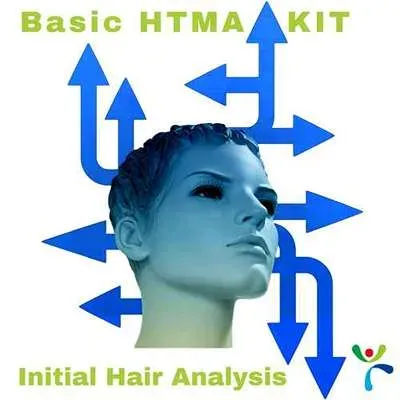Hair Analysis Controversy
A hair analysis is a diagnostic test that utilizes a small sample of hair to assess the body's mineral levels, ratios, and toxic metal burdens. By analyzing the mineral content within hair tissue, practitioners and health enthusiasts aim to gain insights into the body's overall mineral balance, toxic exposure, and metabolic health. When combined with a comprehensive Nutritional Balancing program, hair analysis can serve as a powerful tool to guide individuals toward a healthier lifestyle, optimize nutritional intake, and correct mineral imbalances that may contribute to various health issues.
While the benefits of hair analysis are widely promoted among alternative health practitioners, mainstream medicine and some scientific circles remain skeptical. This skepticism stems largely from concerns over the accuracy, reliability, and interpretation of hair analysis results. As with many diagnostic tools, understanding the controversies and debates surrounding hair analysis is crucial before incorporating it into your health regimen.
The Process of Hair Analysis: How It Works
In a typical hair analysis, a small sample—usually about 1-3 inches of hair—is cut close to the scalp, preferably from the nape of the neck. The sample is then sent to a laboratory for testing. The laboratory processes the sample to determine mineral content, including essential minerals like calcium, magnesium, zinc, and copper, as well as toxic metals such as lead, mercury, cadmium, and aluminum.
All of the United States' commercial hair testing laboratories are inspected and licensed by regulatory agencies, ensuring a standard level of compliance and quality control. Over time, technological advancements have improved the precision and reliability of these tests, making them accessible and useful for guiding nutritional and health interventions.
However, despite the technological progress, controversy persists—particularly regarding how samples are prepared and processed in labs, and how the results are interpreted.
The Controversy: Washing the Hair and Its Implications
One of the most contentious issues in hair analysis revolves around whether laboratories should wash hair samples before testing. Many labs perform a cleaning process involving detergents or chemical solvents to remove surface contaminants like dirt, dust, and environmental residues. At first glance, this seems logical: washing the hair could eliminate superficial contaminants that aren’t representative of internal mineral levels.
But is washing the hair beneficial or detrimental?
Most proponents of hair analysis who oppose washing argue that it can significantly distort the results. Hair is a porous tissue—much like a sponge—that can absorb minerals from the environment, products, and external pollution. The use of harsh detergents or chemical solvents for cleaning can remove water-soluble minerals from the hair tissue itself, not just surface contaminants. This process risks stripping out essential water-soluble minerals like sodium, potassium, and certain trace elements, leading to underestimation of their true levels in the body.
Furthermore, hair naturally reestablishes its mineral content through the scalp’s oil and sweat glands. After cutting hair from the scalp, the hair no longer has access to this ongoing mineral exchange. If the sample is washed in the lab before testing, the test results may not accurately reflect the body's ongoing mineral status, leading to potential misinterpretations.
On the other hand, some argue that washing is necessary to remove external contamination, especially in cases where hair has been exposed to environmental pollutants or residues from hair products. They contend that without washing, the results could be skewed by external factors unrelated to the body's internal mineral status.
However, in practice, reputable laboratories like Analytical Research Labs (ARL), which is highly recommended by practitioners like Dr. Paul Eck, do not wash hair samples prior to testing. Instead, they rely on meticulous sample collection and instruct clients to wash their hair 24-48 hours prior to sampling to minimize external contamination. This approach preserves the internal mineral content, providing a more accurate reflection of the body's true mineral status.
Why the Choice of Laboratory Matters
The choice of laboratory is crucial. Not all labs follow the same protocols. Some may wash samples extensively, risking the removal of water-soluble minerals, while others may skip washing altogether, potentially allowing external contamination to influence results. This inconsistency can lead to discrepancies in results and interpretations.
Analytical Research Labs (ARL) stands out because they do not wash the hair prior to testing. They focus on the mineral ratios and relationships, guided by Dr. Eck’s principles, which are based on the understanding that mineral ratios are more informative than individual mineral levels.
Interpreting Hair Analysis Results: Ratios Over Absolute Values
One of the fundamental principles of hair analysis interpretation, especially in the context of Nutritional Balancing, is the focus on mineral ratios rather than absolute mineral levels. This approach stems from the work of Dr. William Albrecht, PhD, who developed the mineral wheel—a visual representation of how minerals interact and influence each other within the body.
Dr. Paul Eck, founder of ARL, emphasized that analyzing mineral ratios provides a deeper understanding of the body's physiological state, including:
- Organ and gland function
- Mental and emotional tendencies
- Stress response and adaptation
- Nutritional needs and support strategies
For example, a high calcium-to-magnesium ratio might indicate a different metabolic state than a balanced ratio, guiding tailored dietary and supplement recommendations. These ratios can reveal patterns that are not obvious when looking solely at individual mineral levels.
The Focus on Optimal Ratios Versus Averages
Most conventional laboratories report mineral levels based on population averages. However, Dr. Eck’s approach diverges by emphasizing ideal mineral ratios—the ratios that support optimal health rather than merely average functioning. The rationale is that most clients seeking hair analysis are already experiencing health challenges, and thus their mineral levels and ratios are typically below optimal.
By aiming for ideal ratios, practitioners can develop personalized programs to correct imbalances, support detoxification, and restore physiological harmony. This perspective shifts the focus from treating symptoms to addressing root causes by restoring mineral balance.
How Hair Analysis Guides Nutritional Interventions
One of the most compelling aspects of hair analysis is its ability to predict symptoms and suggest dietary and supplement strategies tailored to an individual’s metabolic profile. Based on the mineral ratios and patterns identified, practitioners can recommend:
- Specific foods that support mineral balance
- Targeted supplements to correct deficiencies or excesses
- Lifestyle adjustments to reduce stress and toxicity
For example, a person with signs of adrenal fatigue might benefit from specific mineral supplementation or dietary changes that support adrenal function, as indicated by their hair analysis profile. Similarly, someone with mineral imbalances linked to emotional stress might be guided towards nutrients that support mental health.
Addressing Skepticism: Scientific Validity and Criticisms
Despite its widespread use among alternative health practitioners, hair analysis faces significant skepticism from the scientific community. Critics argue that:
- Mineral levels in hair do not necessarily correlate with internal body mineral status.
- External contamination and environmental exposure can skew results.
- Variability in laboratory procedures leads to inconsistent results.
- There is a lack of standardized reference ranges and validation studies.
Some scientists point out that minerals in hair can be affected by factors such as hair treatments, environmental pollutants, and individual differences in hair growth and composition. Moreover, the absence of large-scale, peer-reviewed studies validating hair analysis as a reliable diagnostic tool contributes to ongoing controversy.
However, proponents contend that when performed correctly—using proper sampling techniques, reliable laboratories like ARL, and focusing on mineral ratios—the results can provide valuable insights into metabolic health and guide effective interventions.
The Role of Hair Analysis in Preventive and Predictive Healthcare
One of the most attractive features of hair analysis is its potential for predictive and preventive healthcare. Instead of waiting for symptoms to manifest, individuals can monitor their mineral status and make proactive adjustments to diet and lifestyle. This aligns with the principles of functional medicine and holistic health, emphasizing early detection and personalized care.
Practical Steps for Those Interested in Hair Analysis
If you're considering hair analysis as part of your health journey, keep in mind:
- Choose a reputable laboratory such as Analytical Research Labs that do not wash hair samples and interpret results based on ideal mineral ratios.
- Follow sample collection instructions carefully, including washing hair 24-48 hours prior to sampling.
- Work with a qualified practitioner knowledgeable in interpreting hair analysis and developing personalized wellness plans.
- Combine hair analysis results with other health assessments for a comprehensive picture.
Supplements and Lifestyle Products for Support
Once mineral imbalances are identified through hair analysis, targeted supplementation can help restore balance. Top-quality products from brands like Endo-met and Trace Nutrients offer specialized formulas to support your wellness program. Proper nutrition, lifestyle modifications, stress management, and detoxification strategies complement mineral balancing efforts.
In conclusion, hair analysis remains a valuable, albeit debated, tool in the realm of personalized health. Its focus on mineral ratios and relationships offers insights into physiological and emotional well-being, guiding tailored interventions. While skepticism persists—particularly around lab procedures like hair washing and the interpretation of results—using reputable labs and understanding the principles behind mineral ratios can maximize its benefits.
Ready to take the first step toward better health? Consider purchasing a hair analysis today and discover your body's unique mineral needs. Pair your results with high-quality supplements from Endo-met and Trace, and start your journey to optimal wellness through informed, personalized care.
This material is for educational purposes only
The preceding statements have not been evaluated by the Food and Drug Administration
This information is not intended to diagnose, treat, cure or prevent any disease.

